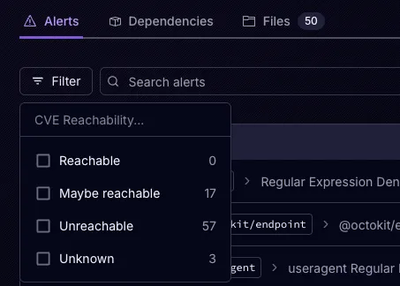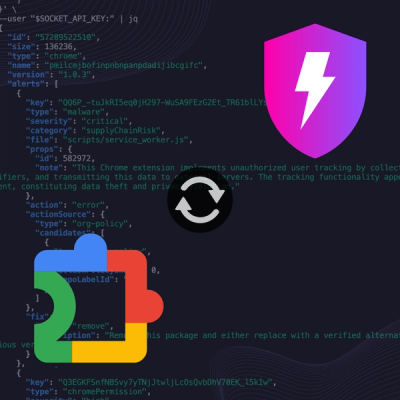
Product
Announcing Precomputed Reachability Analysis in Socket
Socket’s precomputed reachability slashes false positives by flagging up to 80% of vulnerabilities as irrelevant, with no setup and instant results.
Middleware for reading or generating correlation IDs for each incoming request. Correlation IDs can then be added to your logs, making it simple to retrieve all logs generated from a single HTTP request.
When the middleware detects a correlation ID HTTP header in an incoming request, the ID is stored. If no header is found, a correlation ID is generated for the request instead.
The middleware checks for the X-Request-ID header by default, but can be set to any key.
X-Correlation-ID is also pretty commonly used.
Once logging is configured, your output will go from this:
INFO ... project.views This is an info log
WARNING ... project.models This is a warning log
INFO ... project.views This is an info log
INFO ... project.views This is an info log
WARNING ... project.models This is a warning log
WARNING ... project.models This is a warning log
to this:
INFO ... [773fa6885] project.views This is an info log
WARNING ... [773fa6885] project.models This is a warning log
INFO ... [0d1c3919e] project.views This is an info log
INFO ... [99d44111e] project.views This is an info log
WARNING ... [0d1c3919e] project.models This is a warning log
WARNING ... [99d44111e] project.models This is a warning log
Now we're actually able to see which logs are related.
pip install asgi-correlation-id
To set up the package, you need to add the middleware and configure logging.
The middleware can be added like this:
from fastapi import FastAPI
from asgi_correlation_id import CorrelationIdMiddleware
app = FastAPI()
app.add_middleware(CorrelationIdMiddleware)
or any other way your framework allows.
For Starlette apps, just substitute FastAPI with Starlette in all examples.
This section assumes you have already started configuring logging in your project. If this is not the case, check out the section on setting up logging from scratch instead.
To set up logging of the correlation ID, you simply have to add the log-filter the package provides.
If your current log-config looked like this:
LOGGING = {
'version': 1,
'disable_existing_loggers': False,
'formatters': {
'web': {
'class': 'logging.Formatter',
'datefmt': '%H:%M:%S',
'format': '%(levelname)s ... %(name)s %(message)s',
},
},
'handlers': {
'web': {
'class': 'logging.StreamHandler',
'formatter': 'web',
},
},
'loggers': {
'my_project': {
'handlers': ['web'],
'level': 'DEBUG',
'propagate': True,
},
},
}
You simply have to add the filter, like this:
LOGGING = {
'version': 1,
'disable_existing_loggers': False,
+ 'filters': {
+ 'correlation_id': {
+ '()': 'asgi_correlation_id.CorrelationIdFilter',
+ 'uuid_length': 32,
+ 'default_value': '-',
+ },
+ },
'formatters': {
'web': {
'class': 'logging.Formatter',
'datefmt': '%H:%M:%S',
+ 'format': '%(levelname)s ... [%(correlation_id)s] %(name)s %(message)s',
},
},
'handlers': {
'web': {
'class': 'logging.StreamHandler',
+ 'filters': ['correlation_id'],
'formatter': 'web',
},
},
'loggers': {
'my_project': {
'handlers': ['web'],
'level': 'DEBUG',
'propagate': True,
},
},
}
If you're using a json log-formatter, just add correlation-id: %(correlation_id)s to your list of properties.
The middleware can be configured in a few ways, but there are no required arguments.
app.add_middleware(
CorrelationIdMiddleware,
header_name='X-Request-ID',
update_request_header=True,
generator=lambda: uuid4().hex,
validator=is_valid_uuid4,
transformer=lambda a: a,
)
Configurable middleware arguments include:
header_name
strX-Request-IDX-Request-ID and
X-Correlation-ID are common choices.update_request_header
boolTruegenerator
Callable[[], str]lambda: uuid4().hexvalidator
Callable[[str], bool]is_valid_uuid4 (
found here)None, or pass your own validator.transformer
Callable[[str], str]lambda a: aIf you are using cross-origin resource sharing (CORS), e.g. you are making requests to an API from a frontend JavaScript code served from a different origin, you have to ensure two things:
This can be best accomplished by using a dedicated middleware for your framework of choice. Here are some examples.
Docs: https://www.starlette.io/middleware/#corsmiddleware
from starlette.applications import Starlette
from starlette.middleware import Middleware
from starlette.middleware.cors import CORSMiddleware
middleware = [
Middleware(
CORSMiddleware,
allow_origins=['*'],
allow_methods=['*'],
allow_headers=['X-Requested-With', 'X-Request-ID'],
expose_headers=['X-Request-ID']
)
]
app = Starlette(..., middleware=middleware)
Docs: https://fastapi.tiangolo.com/tutorial/cors/
from app.main import app
from fastapi.middleware.cors import CORSMiddleware
app.add_middleware(
CORSMiddleware,
allow_origins=['*'],
allow_methods=['*'],
allow_headers=['X-Requested-With', 'X-Request-ID'],
expose_headers=['X-Request-ID']
)
For more details on the topic, refer to the CORS protocol.
By default, the X-Request-ID response header will be included in all responses from the server, except in the case
of unhandled server errors. If you wish to include request IDs in the case of a 500 error you can add a custom
exception handler.
Here are some simple examples to help you get started. See each framework's documentation for more info.
Docs: https://www.starlette.io/exceptions/
from starlette.requests import Request
from starlette.responses import PlainTextResponse
from starlette.applications import Starlette
from asgi_correlation_id import correlation_id
async def custom_exception_handler(request: Request, exc: Exception) -> PlainTextResponse:
return PlainTextResponse(
"Internal Server Error",
status_code=500,
headers={'X-Request-ID': correlation_id.get() or ""}
)
app = Starlette(
...,
exception_handlers={500: custom_exception_handler}
)
Docs: https://fastapi.tiangolo.com/tutorial/handling-errors/
from app.main import app
from fastapi import HTTPException, Request
from fastapi.exception_handlers import http_exception_handler
from fastapi.responses import JSONResponse
from asgi_correlation_id import correlation_id
@app.exception_handler(Exception)
async def unhandled_exception_handler(request: Request, exc: Exception) -> JSONResponse:
return await http_exception_handler(
request,
HTTPException(
500,
'Internal server error',
headers={'X-Request-ID': correlation_id.get() or ""}
))
If you are using CORS, you also have to include the Access-Control-Allow-Origin and Access-Control-Expose-Headers
headers in the error response. For more details, see the CORS section above.
If your project does not have logging configured, this section will explain how to get started. If you want even more details, take a look at this blogpost .
The Python docs explain there are a few configuration functions
you may use for simpler setup. For this example we will use dictConfig, because that's what, e.g., Django users should
find most familiar, but the different configuration methods are interchangable, so if you want to use another method,
just browse the python docs and change the configuration method as you please.
The benefit of dictConfig is that it lets you specify your entire logging configuration in a single data structure,
and it lets you add conditional logic to it. The following example shows how to set up both console and JSON logging:
from logging.config import dictConfig
from app.core.config import settings
def configure_logging() -> None:
dictConfig(
{
'version': 1,
'disable_existing_loggers': False,
'filters': { # correlation ID filter must be added here to make the %(correlation_id)s formatter work
'correlation_id': {
'()': 'asgi_correlation_id.CorrelationIdFilter',
'uuid_length': 8 if not settings.ENVIRONMENT == 'local' else 32,
'default_value': '-',
},
},
'formatters': {
'console': {
'class': 'logging.Formatter',
'datefmt': '%H:%M:%S',
# formatter decides how our console logs look, and what info is included.
# adding %(correlation_id)s to this format is what make correlation IDs appear in our logs
'format': '%(levelname)s:\t\b%(asctime)s %(name)s:%(lineno)d [%(correlation_id)s] %(message)s',
},
},
'handlers': {
'console': {
'class': 'logging.StreamHandler',
# Filter must be declared in the handler, otherwise it won't be included
'filters': ['correlation_id'],
'formatter': 'console',
},
},
# Loggers can be specified to set the log-level to log, and which handlers to use
'loggers': {
# project logger
'app': {'handlers': ['console'], 'level': 'DEBUG', 'propagate': True},
# third-party package loggers
'databases': {'handlers': ['console'], 'level': 'WARNING'},
'httpx': {'handlers': ['console'], 'level': 'INFO'},
'asgi_correlation_id': {'handlers': ['console'], 'level': 'WARNING'},
},
}
)
With the logging configuration defined within a function like this, all you have to do is make sure to run the function
on startup somehow, and logging should work for you. You can do this any way you'd like, but passing it to
the FastAPI.on_startup list of callables is a good starting point.
structlog is a Python library that enables structured logging.
It is trivial to configure with asgi_correlation_id:
import logging
from typing import Any
import structlog
from asgi_correlation_id import correlation_id
def add_correlation(
logger: logging.Logger, method_name: str, event_dict: dict[str, Any]
) -> dict[str, Any]:
"""Add request id to log message."""
if request_id := correlation_id.get():
event_dict["request_id"] = request_id
return event_dict
structlog.configure(
processors=[
add_correlation,
structlog.stdlib.filter_by_level,
structlog.stdlib.add_logger_name,
structlog.stdlib.add_log_level,
structlog.processors.TimeStamper(fmt="%Y-%m-%d %H:%M.%S"),
structlog.processors.StackInfoRenderer(),
structlog.processors.format_exc_info,
structlog.processors.JSONRenderer(),
],
wrapper_class=structlog.stdlib.BoundLogger,
logger_factory=structlog.stdlib.LoggerFactory(),
cache_logger_on_first_use=True,
)
If you're using saq, you can easily transfer request IDs from the web server to your workers by using the event hooks provided by the library:
from uuid import uuid4
from asgi_correlation_id import correlation_id
from saq import Job, Queue
CID_TRANSFER_KEY = 'correlation_id'
async def before_enqueue(job: Job) -> None:
"""
Transfer the correlation ID from the current context to the worker.
This might be called from a web server or a worker process.
"""
job.meta[CID_TRANSFER_KEY] = correlation_id.get() or uuid4()
async def before_process(ctx: dict) -> None:
"""
Load correlation ID from the enqueueing process to this one.
"""
correlation_id.set(ctx['job'].meta.get(CID_TRANSFER_KEY, uuid4()))
async def after_process(ctx: dict) -> None:
"""
Reset correlation ID for this process.
"""
correlation_id.set(None)
queue = Queue(...)
queue.register_before_enqueue(before_enqueue)
priority_settings = {
...,
'queue': queue,
'before_process': before_process,
'after_process': after_process,
}
To add a correlation ID to your hypercorn logs, you'll need to add a log filter and change the log formatting. Here's an example of how to configure hypercorn, if you're running a FastAPI app:
import logging
import os
from fastapi import APIRouter, FastAPI
from hypercorn.config import Config
from hypercorn.asyncio import serve
import asgi_correlation_id
import asyncio
import hypercorn
def configure_logging():
console_handler = logging.StreamHandler()
console_handler.addFilter(asgi_correlation_id.CorrelationIdFilter())
logging.basicConfig(
handlers=[console_handler],
level="INFO",
format="%(levelname)s log [%(correlation_id)s] %(name)s %(message)s")
app = FastAPI(on_startup=[configure_logging])
app.add_middleware(asgi_correlation_id.CorrelationIdMiddleware)
router = APIRouter()
@router.get("/test")
async def test_get():
print("toto")
logger = logging.getLogger()
logger.info("test_get")
app.include_router(router)
if __name__ == "__main__":
logConfig = {
"handlers": {
"hypercorn.access": {
"formatter": "hypercorn.access",
"level": "INFO",
"class": "logging.StreamHandler",
"stream": "ext://sys.stdout",
"filters": [
asgi_correlation_id.CorrelationIdFilter()
],
}},
"formatters": {
"hypercorn.access": {
"format": "%(message)s %(correlation_id)s",
}
},
"loggers": {
"hypercorn.access": {
"handlers": [
"hypercorn.access"
],
"level": "INFO",
},
},
"version": 1
}
config = Config()
# write access log to stdout
config.accesslog = "-"
config.logconfig_dict = logConfig
asyncio.run(serve(app, config))
# run it
$ python3 test.py
# test it:
$ curl http://localhost:8080/test
# log on stdout:
INFO log [7e7ccfff352a428991920d1da2502674] root test_get
127.0.0.1:34754 - - [14/Dec/2023:10:34:08 +0100] "GET /test 1.1" 200 4 "-" "curl/7.76.1" 7e7ccfff352a428991920d1da2502674
To add a correlation ID to your uvicorn logs, you'll need to add a log filter and change the log formatting. Here's an example of how to configure uvicorn, if you're running a FastAPI app:
import logging
import os
import asgi_correlation_id
import uvicorn
from fastapi import APIRouter, FastAPI
from uvicorn.config import LOGGING_CONFIG
def configure_logging():
console_handler = logging.StreamHandler()
console_handler.addFilter(asgi_correlation_id.CorrelationIdFilter())
logging.basicConfig(
handlers=[console_handler],
level="INFO",
format="%(levelname)s log [%(correlation_id)s] %(name)s %(message)s")
app = FastAPI(on_startup=[configure_logging])
app.add_middleware(asgi_correlation_id.CorrelationIdMiddleware)
router = APIRouter()
@router.get("/test")
async def test_get():
logger = logging.getLogger()
logger.info("test_get")
app.include_router(router)
if __name__ == "__main__":
LOGGING_CONFIG["handlers"]["access"]["filters"] = [asgi_correlation_id.CorrelationIdFilter()]
LOGGING_CONFIG["formatters"]["access"]["fmt"] = "%(levelname)s access [%(correlation_id)s] %(name)s %(message)s"
uvicorn.run("test:app", port=8080, log_level=os.environ.get("LOGLEVEL", "DEBUG").lower())
# run it
python test.py
# test it
curl http://localhost:8080/test
# log on stdout
INFO log [16b61d57f9ff4a85ac80f5cd406e0aa2] root test_get
INFO access [16b61d57f9ff4a85ac80f5cd406e0aa2] uvicorn.access 127.0.0.1:24810 - "GET /test HTTP/1.1" 200
In addition to the middleware, we've added a couple of extensions for third-party packages.
If your project has sentry-sdk
installed, correlation IDs will automatically be added to Sentry events as a transaction_id.
See this blogpost for a little bit of detail. The transaction ID is displayed in the event detail view in Sentry and is just an easy way to connect logs to a Sentry event.
Note: If you're using the celery integration, install the package with
pip install asgi-correlation-id[celery]
For Celery user's there's one primary issue: workers run as completely separate processes, so correlation IDs are lost when spawning background tasks from requests.
However, with some Celery signal magic, we can actually transfer correlation IDs to worker processes, like this:
@before_task_publish.connect()
def transfer_correlation_id(headers) -> None:
# This is called before task.delay() finishes
# Here we're able to transfer the correlation ID via the headers kept in our backend
headers[header_key] = correlation_id.get()
@task_prerun.connect()
def load_correlation_id(task) -> None:
# This is called when the worker picks up the task
# Here we're able to load the correlation ID from the headers
id_value = task.request.get(header_key)
correlation_id.set(id_value)
To configure correlation ID transfer, simply import and run the setup function the package provides:
from asgi_correlation_id.extensions.celery import load_correlation_ids
load_correlation_ids()
In addition to transferring request IDs to Celery workers, we've added one more log filter for improving tracing in celery processes. This is completely separate from correlation ID functionality, but is something we use ourselves, so keep in the package with the rest of the signals.
The log filter adds an ID, celery_current_id for each worker process, and an ID, celery_parent_id for the process
that spawned it.
Here's a quick summary of outputs from different scenarios:
| Scenario | Correlation ID | Celery Current ID | Celery Parent ID |
|---|---|---|---|
| Request | ✅ | ||
| Request -> Worker | ✅ | ✅ | |
| Request -> Worker -> Another worker | ✅ | ✅ | ✅ |
| Beat -> Worker | ✅* | ✅ | |
| Beat -> Worker -> Worker | ✅* | ✅ | ✅ |
*When we're in a process spawned separately from an HTTP request, a correlation ID is still spawned for the first process in the chain, and passed down. You can think of the correlation ID as an origin ID, while the combination of current and parent-ids as a way of linking the chain.
To add the current and parent IDs, just alter your celery.py to this:
+ from asgi_correlation_id.extensions.celery import load_correlation_ids, load_celery_current_and_parent_ids
load_correlation_ids()
+ load_celery_current_and_parent_ids()
If you wish to correlate celery task IDs through the IDs found in your broker (i.e., the celery task_id), use the use_internal_celery_task_id argument on load_celery_current_and_parent_ids
from asgi_correlation_id.extensions.celery import load_correlation_ids, load_celery_current_and_parent_ids
load_correlation_ids()
+ load_celery_current_and_parent_ids(use_internal_celery_task_id=True)
Note: load_celery_current_and_parent_ids will ignore the generator argument when use_internal_celery_task_id is set to True
To set up the additional log filters, update your log config like this:
LOGGING = {
'version': 1,
'disable_existing_loggers': False,
'filters': {
'correlation_id': {
+ '()': 'asgi_correlation_id.CorrelationIdFilter',
+ 'uuid_length': 32,
+ 'default_value': '-',
+ },
+ 'celery_tracing': {
+ '()': 'asgi_correlation_id.CeleryTracingIdsFilter',
+ 'uuid_length': 32,
+ 'default_value': '-',
+ },
},
'formatters': {
'web': {
'class': 'logging.Formatter',
'datefmt': '%H:%M:%S',
'format': '%(levelname)s ... [%(correlation_id)s] %(name)s %(message)s',
},
+ 'celery': {
+ 'class': 'logging.Formatter',
+ 'datefmt': '%H:%M:%S',
+ 'format': '%(levelname)s ... [%(correlation_id)s] [%(celery_parent_id)s-%(celery_current_id)s] %(name)s %(message)s',
+ },
},
'handlers': {
'web': {
'class': 'logging.StreamHandler',
'filters': ['correlation_id'],
'formatter': 'web',
},
+ 'celery': {
+ 'class': 'logging.StreamHandler',
+ 'filters': ['correlation_id', 'celery_tracing'],
+ 'formatter': 'celery',
+ },
},
'loggers': {
'my_project': {
+ 'handlers': ['celery' if any('celery' in i for i in sys.argv) else 'web'],
'level': 'DEBUG',
'propagate': True,
},
},
}
With these IDs configured you should be able to:
With everything configured, assuming you have a set of tasks like this:
@celery.task()
def debug_task() -> None:
logger.info('Debug task 1')
second_debug_task.delay()
second_debug_task.delay()
@celery.task()
def second_debug_task() -> None:
logger.info('Debug task 2')
third_debug_task.delay()
fourth_debug_task.delay()
@celery.task()
def third_debug_task() -> None:
logger.info('Debug task 3')
fourth_debug_task.delay()
fourth_debug_task.delay()
@celery.task()
def fourth_debug_task() -> None:
logger.info('Debug task 4')
your logs could look something like this:
correlation-id current-id
| parent-id |
| | |
INFO [3b162382e1] [ - ] [93ddf3639c] project.tasks - Debug task 1
INFO [3b162382e1] [93ddf3639c] [24046ab022] project.tasks - Debug task 2
INFO [3b162382e1] [93ddf3639c] [cb5595a417] project.tasks - Debug task 2
INFO [3b162382e1] [24046ab022] [08f5428a66] project.tasks - Debug task 3
INFO [3b162382e1] [24046ab022] [32f40041c6] project.tasks - Debug task 4
INFO [3b162382e1] [cb5595a417] [1c75a4ed2c] project.tasks - Debug task 3
INFO [3b162382e1] [08f5428a66] [578ad2d141] project.tasks - Debug task 4
INFO [3b162382e1] [cb5595a417] [21b2ef77ae] project.tasks - Debug task 4
INFO [3b162382e1] [08f5428a66] [8cad7fc4d7] project.tasks - Debug task 4
INFO [3b162382e1] [1c75a4ed2c] [72a43319f0] project.tasks - Debug task 4
INFO [3b162382e1] [1c75a4ed2c] [ec3cf4113e] project.tasks - Debug task 4
FAQs
Middleware correlating project logs to individual requests
We found that asgi-correlation-id demonstrated a healthy version release cadence and project activity because the last version was released less than a year ago. It has 1 open source maintainer collaborating on the project.
Did you know?

Socket for GitHub automatically highlights issues in each pull request and monitors the health of all your open source dependencies. Discover the contents of your packages and block harmful activity before you install or update your dependencies.

Product
Socket’s precomputed reachability slashes false positives by flagging up to 80% of vulnerabilities as irrelevant, with no setup and instant results.

Product
Socket is launching experimental protection for Chrome extensions, scanning for malware and risky permissions to prevent silent supply chain attacks.

Product
Add secure dependency scanning to Claude Desktop with Socket MCP, a one-click extension that keeps your coding conversations safe from malicious packages.